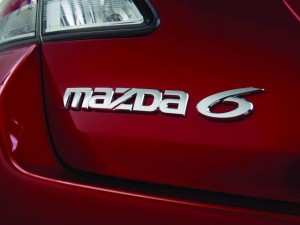Timing is everything.
So after launching the 2009 model Mazda6 on the eve of the financial crisis last summer, the Japanese automaker plans to, well, re-launch or “continue the launch” of the mid-size four-door sedan that is a critical part of the company’s model line in the U.S.
The latest marketing move sells the deal. The price is being cut with help from a higher residual value from Automotive Lease Guide, Mazda officials said. On average prices for comparably equipped vehicles are dropping about $500.
For the 2010 model year, Mazda6 offers what is in the business known as “minor trim and package enhancements.” To streamline the most popular options, a new Touring Plus model is added to both the 6i as 6s models. It adds a power moon roof, ground illumination or what used to be called running lights Bluetooth, electroluminescent gauges, a blind spot monitoring system and an anti-theft alarm.
The “technology package” offered on Grand Touring models includes a multi information display for the audio and Bluetooth, which is also standard with the Technology Package.
Xenon headlights, keyless entry, push-button start, heated mirrors, Sirius satellite radio and Blind Spot Monitoring System are also standard on Mazda6, which company claims help win over customers from other Japanese brands.
“We’re staying with our message,” said Tim Barnes, Mazda North America’s director of product planning and strategy. “We have a very compelling story to tell against the Toyota Camry and Honda Accord,” he said, The base price for the Mazda6i Touring model is $20,900 or roughly $1,000 less than a mid-sized Toyota or Honda with less equipment.
Mazda, of course, has been chasing and chasing both Toyota and Honda for decades now in the U.S. market. While it has a loyal following among owners, it’s sales numbers pale against the Japanese “big three,” which also include Nissan. Whether it has the marketing muscle to take a serious run at these players has been debated for a long, long time.
Still, in keeping with Japanese practices, the Mazda6 comes with standard features including air conditioning with a pollen filter, power door locks and windows, a tilt and telescopic steering wheel, height-adjustable driver’s seat, 60/40 split-folding rear seats, MP3 compatible stereo, 16-inch wheels, power-assisted rack-and-pinion steering, tire pressure monitor system (TPMS), side air bags and curtains, anti-lock braking (ABS), dynamic stability control (DSC) and traction control (TCS).
Jim O’Sullivan, Mazda North America president and chief executive officer, defended Mazda’s decision to halt production of the Mazda 6 last winter as industry-wide sales dropped to their lowest levels in more than 40 years. Mazda could have parked the Mazda 6 in rental fleets but that would hurt in the competition with Toyota and Honda, which enjoy strong residual values for buyers in the mid-sized segment, O’Sullivan said.
Production of the Mazda6 resumed last month at assembly plant in Flat Rock, Michigan, which is operated as a joint venture with the Ford Motor Company. The next objective is to raise awareness of the vehicle so the Mazda6 winds up on more shopping lists, Barnes said.
The car itself remains a strong entry, in my opinion. When the Mazda 6 design effort commenced in the spring of 2004, Chief Designer Youichi Sato challenged designers working on the project to create a wholly fresh, upscale, premium – yet still sporty – appearance for the North America and to evolve the “Zoom-Zoom” spirit of advertising fame to the next level. The 6 was also designed reflect its Japanese heritage in aesthetics, and spirit.
The harmony of sharp edges with richly curved surfaces still defines to the Mazda 6’s visual appeal, according to Derek Jenkins, MNAO director of design.
Barnes also said the market has shifted toward four-cylinder engines and the 2.5-liter 4-cylinder engine is available with an ample amount of the right stuff, packing 170 horsepower at 6,000 rpm. Its peak torque of 167 lb-ft at 4,000 rpm tops nearly all competitors’ engines. EPA fuel economy is 21 city/30 hwy on automatic and 20 city/29 highway when equipped with the increasing rare manual transmission.
The other engine available on the Mazda 6 is the 60-degree 3.7-liter V6 ( MZI engine in the jargon), which Mazda boasts is the most powerful engine in its class, producing 272 horsepower at 6,250 rpm and 269 pound-feet of torque at 4,250 rpm. Mazda engineering tests are said to show that it’s also quieter than its competitors at full throttle. EPA fuel economy is 17 city/25 hwy with its standard-equipment automatic transmission.
Barnes said one of Mazda’s top priorities is to offer customers a vehicle that are utterly dependable, perfectly designed and manufactured, and pleasing to a broad spectrum of people – in short the clichéd goal of all mass marketers
All 2010 Mazdas come with a roadside assistance program. With a call to a toll-free number, owners can access roadside assistance 24 hours a day, 365 days a year throughout the United States and Canada. In addition, a comprehensive three-year/36,000-mile warranty covers every part on the vehicle except those subject to normal wear. Also, all 2010 models receive a five-year/60,000 mile powertrain warranty and a five-year/unlimited-mileage corrosion warranty.
Located in in Irvine, California, Mazda North American Operations oversees the sales, marketing, parts and customer service support of Mazda vehicles in the United States, Canada and Mexico through nearly 900 dealers. Operations in Canada are managed by Mazda Canada, Inc., located in Ontario, Canada, and in Mexico by Mazda Motor de Mexico in Mexico City.


